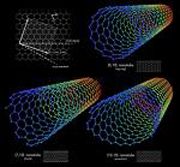 Composite materials reinforced with carbon nanotube “stitching” are not only ten times stronger than those that go without, but they are also one million times more electrically conductive, according to a report soon to be published in the Journal of Composite Materials. Benefits to aircraft structures therefore include increased strength and lightning protection along with decreased weight for composite aircraft. Carbon nanotubes are not new, and have been flown aboard aircraft, including a Giles G-200 high-performance homebuilt aerobatic aircraft in 2008, as part of that aircraft’s cowling. But researchers at MIT say that through a process called “nanostitching,” they can add nanotubes, “the strongest fibers known to humankind,” to the composite’s weakest part — between its layers — adding strength, without adding weight. And that’s not nearly all they can do.
Composite materials reinforced with carbon nanotube “stitching” are not only ten times stronger than those that go without, but they are also one million times more electrically conductive, according to a report soon to be published in the Journal of Composite Materials. Benefits to aircraft structures therefore include increased strength and lightning protection along with decreased weight for composite aircraft. Carbon nanotubes are not new, and have been flown aboard aircraft, including a Giles G-200 high-performance homebuilt aerobatic aircraft in 2008, as part of that aircraft’s cowling. But researchers at MIT say that through a process called “nanostitching,” they can add nanotubes, “the strongest fibers known to humankind,” to the composite’s weakest part — between its layers — adding strength, without adding weight. And that’s not nearly all they can do.
Composite structures are strengthened by adding layers or plies of composite fiber on top of one another, bonded by resin. Nanostitching aligns rows of carbon nanotubes perpendicular to the layered fibers of a carbon composite structure, effectively filling the spaces between them and stitching the layers together without adding weight. Nanostitching does not add weight to the structure, because the nanotubes exist in space formerly taken up solely by heavier, weaker resin. The process actually increases strength and saves weight (as it was in the case of the G-200).
Researchers have shown that when embedded in aircraft wings with other polymer composites, carbon nanotubes mixed into an epoxy coating can be used to initiate “self-healing” repairs of damaged structure. The “self-healing” is actually initiated by application of an electrical charge that the nanotubes conduct, allowing heat-activated agents mixed into the composite to flow into cracks, stopping propagation and recovering 70 percent of the structure’s original strength. In this application weight is added to the structure — but, say researchers, it accounts for only 1 percent of the polymer composite’s total weight. The nanotubes, however, do not act on their own to find the cracks. They are used to form a grid over a surface that allows it to be tested for imperfections, and then supply conductivity to initiate the “healing” process.


































